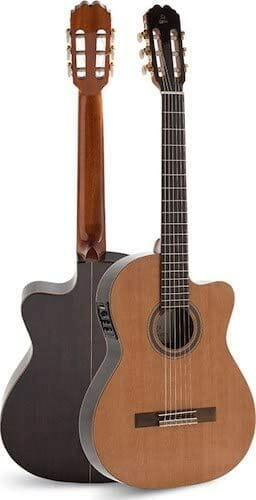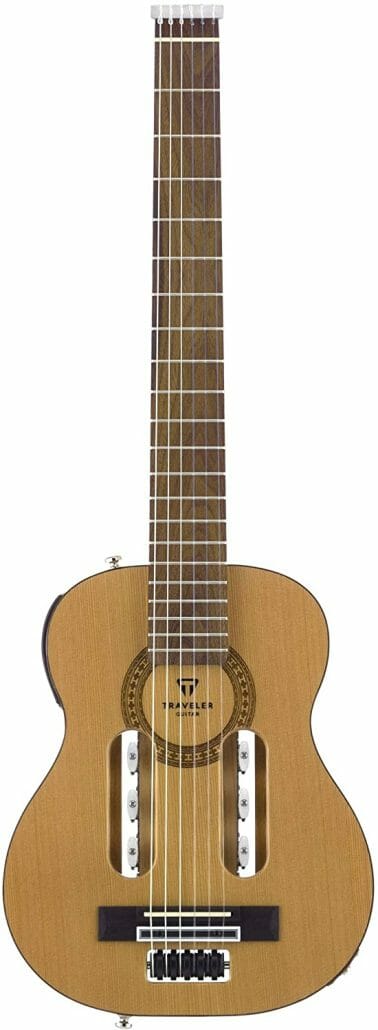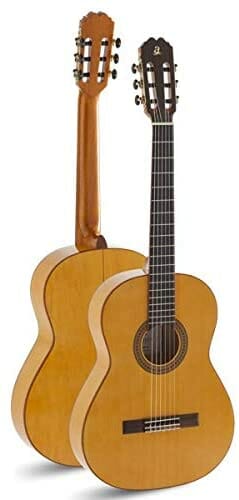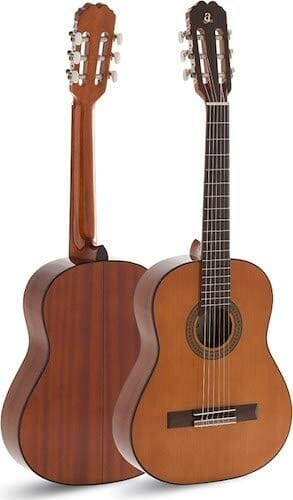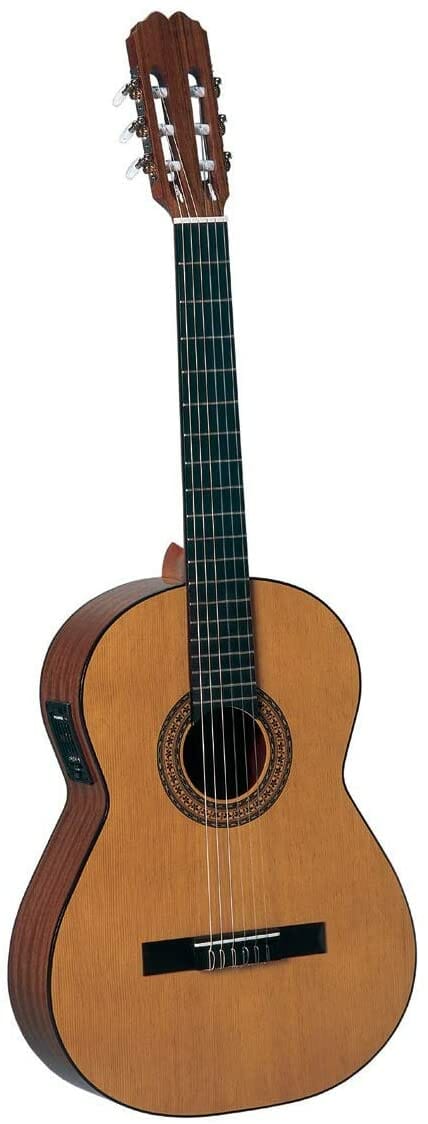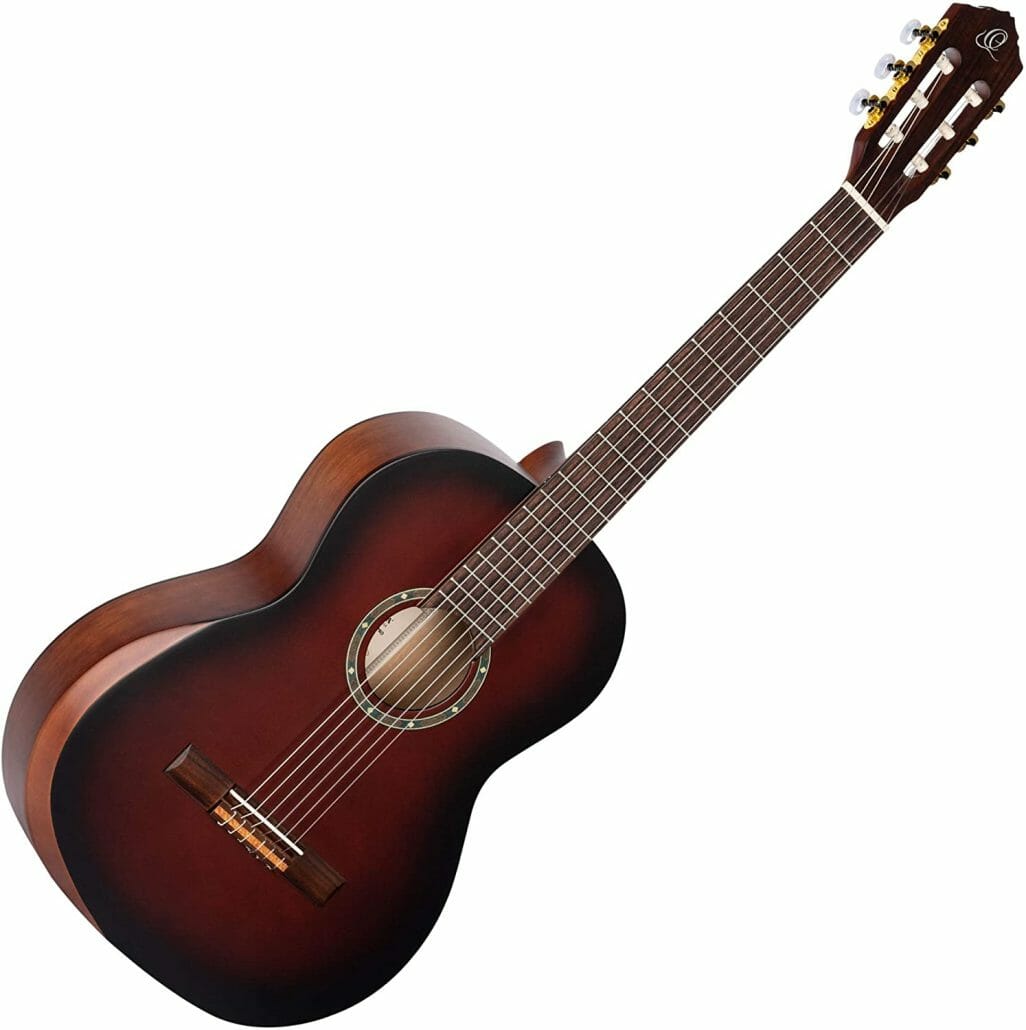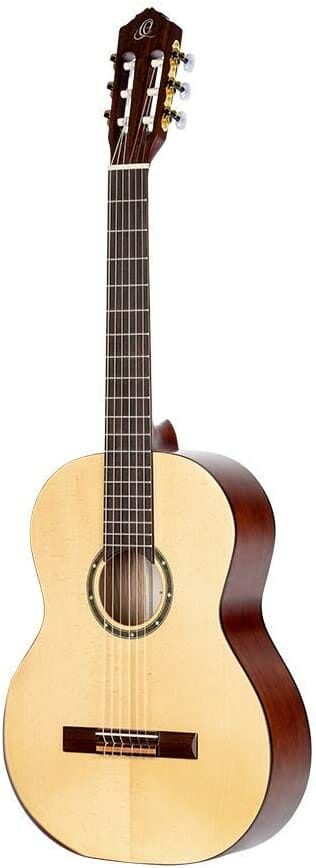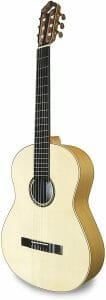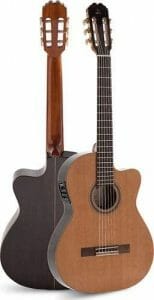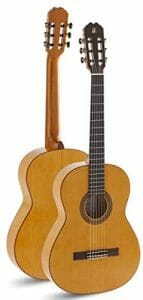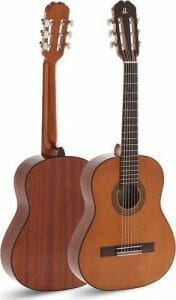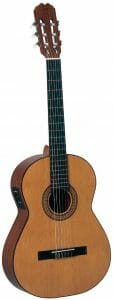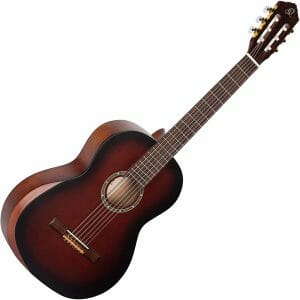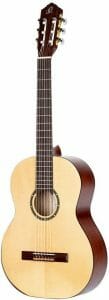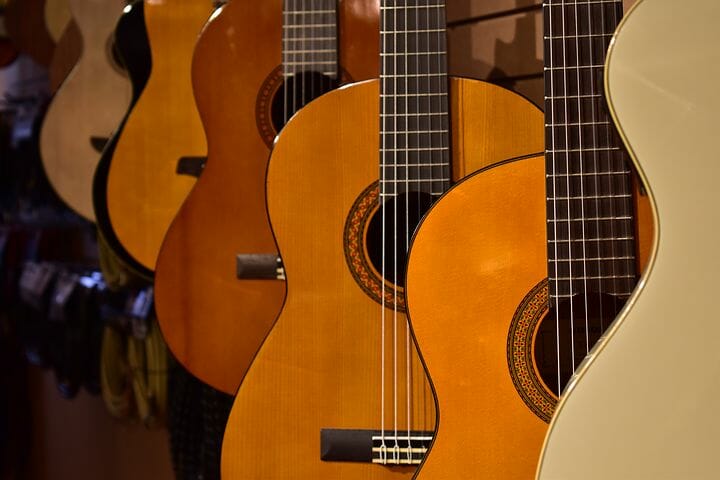The Ultimate List of Classical Guitars Under US $300 – 2025
We’re guessing you’re here because you found yourself to have some budget to spare to get a classical guitar. You’ve listened to a few classical songs thinking, “yeah, I wanna learn how to do that, too!” That’s why we decided to compile a list of some classical guitars within your price range, so searching would be more convenient. We list down everything you need to know and everything that you should look out for when buying a classical guitar (of course, we know that we shouldn’t consider this to be like an acoustic guitar, right?) So without further ado, here is the list!
Top 8 Classical Guitars Under $300 2021
1. Cap Classical Guitar, Right (Luthier F) – The Albino Choice
- Size: full sized
- Material: Spruce top, cypress back and sides
- Thickness: 3.94 inches
- Weight: 3.08 pounds
- Outstanding feature: exotic tone wood, peculiar tonality, great sound projection and aesthetic
This light-toned stunner sounds just as good as you think it would – offering a very unique soundscape due to the amalgamation of several various tonewoods. The Cap Luthier F Right-Handed Classical Guitar is undeniably hard to go wrong with, especially that mix of exotic tonewoods it has ultimately creates a very unique soundscape that’s quite hard to resist. The spruce top manages to boost the overall sound projection, the cypress back and sides deals with the warm and overall sharpness, the acacia delivers quite a familiar feel and a good intonation – all of which make up for quite a guitar that proves to work well from beginners up to the seasoned experts.
- Elegant spruce top and cypress sides
- The light-toned aesthetic is an easy standout
- The overall sound quality and tonality is supremely unique
- People may prefer a more familiar tone wood than cypress
- People may opt for a darker-finished aesthetic
- The acacia neck may prove to have a bit of getting used to
2. Admira 6 String Classical Guitar, Right (VIRTUOSO-ECTF) – The Darker Choice
- Size: Full sized
- Material: cedar body, sapele wood sides and back, mahogany neck, kabukalli fretboard
- Thickness: 7 inches
- Weight: 5.04 pounds
- Outstanding feature: exotic mix of tonewoods, cutaway for more frets to reach, great sound quality and projection
Admira’s VIRTUOSO-ECTF entry to this list offers quite an array of tonewoods compressed into one guitar. Boasting a cedar top, sapele wood back and sides, a mahogany neck, and a kabukalli fretboard, you already know you’re in for a treat as you try and power through playing with this interesting mixture of tonewoods. What’s even cooler about this guitar is the luthier’s decision to add a cutaway, overall giving the player a better reach of frets 12 and above. The hardtail bridge also proves to be a great addition, overall putting out a guitar that’s worth breaking the bank for.
- Exquisite cedar and sapele wood finish
- Luscious warm and deep tones
- Great build and bracing
- Some may still prefer the mahogany sound and tone over this
- The finish may be too dark for some
- The cutaway may prove to be limiting for left handed players
3. Traveler Guitar Escape Classical (Cedar Top) (ESC CDG) – The Extremely Unique Choice
- Size: Full sized
- Material: cedar top, alder body, maple neck, walnut fingerboard
- Thickness: 2.13 inches
- Weight: 5 pounds
- Outstanding feature: interesting tonewood, unique aesthetic, great tuning mechanism and electric capability
Traveler Guitar manages to grab all the attention by offering the Escape Classical ESC CDG guitar. The first thing you’d notice from this model is how straightforward it is in being, well, weird – as the lack of a head is compensated by replacing the soundhole with the gear tuners. It also has an altered bridge but still manages to pack up warmth and sound projection through using a cedar top, alder back and sides, maple neck, and walnut fingerboard. The only long term problem this guitar would pose is the difficulty in seeking for strings long enough for this guitar. Other than that, it’s a beautiful spectacle of a guitar that manages to bring in a uniquely astonishing soundscape.
- It’s a beautiful looking classical guitar
- It offers quite a distinct sound thanks to the rare tonewoods
- The weird mechanism and electronic capability make it quite the stand out
- Some may prefer the sound of a normally manufactured classical guitar better
- Replacement parts are obscure and hard to find
- Some may opt for a spruce topped classical guitar with a mahogany back and side instead
4. Admira 6 String Classical Guitar, Right (TRIANA) – The Straightforward Choice
- Size: Full
- Material: spruce top, maple back and sides, mahogany neck, kabukalli fretboard
- Thickness: 7 inches
- Weight: 4.89 pounds
- Outstanding feature: very straightforward build, great finish, nice feel and overall playability
Admira’s TRIANA entry is a guitar that takes pride in its simplicity – offering a guitar that’s easy to pick up and start learning or jamming on. This TRIANA model from Admira boasts a spruce top that’s partnered with a maple back and side to give a luscious tone that sticks out with a bit of punch. The mahogany neck gives the guitar a familiar feel as you hold it, while the kabukalli fretboard offers a play feel that’s quite new to most players trying to go around notes and riffs on this wonderful classical instrument.
- It’s a classical guitar that’s hard to go wrong with
- Superb and on-point sound quality
- It offers Admira’s typical build in the most straightforward fashion
- It could’ve been a bit more creative
- Some may still look for a classical guitar with mahogany back and sides instead
- The kabukalli fretboard may take a bit of getting used to
5. Admira 6 String Classical Guitar, Right (JUANITA 1/2) – The Smaller Choice
- Size: 1/2
- Material: cedar top, sapele wood back and sides, mahogany neck, kabukalli fingerboard
- Thickness: 6 inches
- Weight: 3.69 pound
- Outstanding feature: great size, great build, astonishing aesthetic, and overall great sound quality
This shocker of an entry from Admira offers the classical guitar in half the size but manages to bring the sound still in full. As it boasts quite an array of tonewoods, the JUANITA-1/2 successfully allows people to enjoy the full signature Admira size in a relatively smaller body. Offering typical Admira offerings – from the cedar top, sapele wood back and sides, mahogany neck, and kabukalli fingerboard – you’re sure to never go wrong with opting for an Admira axe.
- Great build quality and bracing
- Great optional sizing
- Charming finish and sound quality
- Some players may not appreciate the tone it delivers
- Some may want a full sized instead
- The kabukalli fretboard feel may take a bit of getting used to
6. Admira 6 String Classical Guitar, Right (JUANITA-E) – A Standard Choice
- Size: Full-sized
- Material: spruce top, sapele back and sides, mahogany neck, and kabukalli fingerboard b
- Thickness: 7 inches
- Weight: 5.28 pounds
- Outstanding feature: great tone, clean aesthetic, wonderful neck intonation
The JUANITA-E is Admira’s competitor to the everyday classical guitar – offering an entry with a Fishman Classica III pickup, nickel machine heads, a hardtail Kabukalli bridge, and a set of nickel machine heads. It also comes in a high gloss finish that well emphasizes the spruce top, sapele back and sides, african mahogany neck and the kabukalli fingerboard. It has everything that Admira desires to boast, proving it’s a guitar that’s far from being disappointing. Trust us, this guitar is an easy pick me up that would take a long time before you’d want to put it down.
- Astounding use of an array of tonewoods
- A beautiful build quality and bracing
- Classic aesthetic that never goes wrong
- May be too simple for some
- People may prefer for a more exotic or rare tonality
- People may opt for a different feel from kabukalli
7. Ortega Guitars 6 String Family Series Pro w/Arm Rest Solid Top Nylon Classical Guitar, Right (R55DLX-BFT) – The Signature Choice
- Size: full-sized
- Material: spruce top, catalpa back and sides, nato wood neck, and walnut fretboard
- Thickness: 5 inches
- Weight: 4 pounds
- Outstanding feature: very unique build and well-manufactured bracing
This Ortega Guitar entry is not your typical classical guitar – it comes with an ebony finish that’s a sight to behold. Truth be told, this guitar is a silent stunner, as it comes with a hole bridge (for better sound and faster string replacement), fan bracing, pearl buttons, chrome-plated tuning gears, a 2 way truss rod, a walnut armrest, black ABS binding, a natural satin mahogany neck, a solid Engelmann spruce top, mahogany bourbon-finished back and sides, and also the use of walnut on the bridge and fretboard. This guitar manages to provide a tone that’s as warm as its finish, not to mention the fact that it feels so good to play with. How can you resist such a charming classical guitar? We, for one, can’t!
- Super unique aesthetic and finish
- Well made build and bracing
- Superior sound quality and tonality
- People may opt for a lighter finished guitar
- Some may want to opt for a more familiar sounding tone wood
- The walnut fingerboard may take a bit of getting used to
8. Ortega Guitars 6 String Family Series Pro w/Arm Rest Solid Top Nylon Classical Guitar, Right – The Alternative Choice
- Size: full sized
- Material: spruce top, catalpa back and sides, nato wood neck, and walnut fretboard
- Thickness: 5 inches
- Weight: 4. pounds
- Outstanding feature: great finish, clean build, great sound quality
This entry from Ortega Guitar offers a lighter top than its cousin but still manages to astound. Nicknames the R55DLX, the guitar boasts a hole bridge (for better break angle and easier string replacement), chrome-plated tuning machines, pearl buttons, fan bracing, black ABS binding, a walnut armrest, bridge, and fingerboard, a natural satin mahogany neck, a solid Engelmann spruce top, and a sound projection and overall tonality that would leave everyone’s jaws dropped.
- Great finish and sound
- Amazing build quality and bracing choice
- The guitar feels super great to play on
- People may opt for more familiar sounding tonewoods
- Players may take some time getting used to the walnut fretboard
- People may feel that the finish is too light
Tips on Finding the Right Classical Guitar for You
Sometimes, lists just don’t do enough justice in proving the worth of an instrument. That’s why we also decided to add a quick FAQ and several tips that should more or less help you in picking out the perfect classical guitar that would fit your playstyle.
What to Expect at 300 Dollars
Shelling out 300 dollars should be enough to get you a ukulele of great sound quality, but it’s still not a guitar that you’d love to take out to play live performances or gigs. It’s a practice guitar for what it’s worth, as most great sounding and amazing playing classical guitars usually require 500 dollars for the quality.
At 300 dollars, you do get what you’ve paid for and sometimes a little bit more. What luthiers tend to do at this price point is offer an array of inclusions ranging from clip-on tuners, microfiber cloths, capos, guitar stands, steps, and instructables. But just by looking at it, you’d easily realize it’s more of a ruse than an actual samaritan effort. You’d realize it’s only part of the package since it emanates a certain scent of convenience, not to mention the fact that it would seem like you’re getting the guitar at such a steal of a price. What people fail to realize here is that it’s free because they want to really push the guitar that experts don’t want, and the inclusions would easily attract consumers that are just starting out.
Also, you’d probably see several guitars with the same tonewoods from different manufacturers. You’d realize the price would also differ, easily how the build, bracing, and finish of one guitar is far superior than the other. This is normal with most manufacturers, and it’s meant to be that way so people have an option on what “tier” they would want to shell out on. Not everyone would like to play like their livelihood depends on it, so it would be understandable that people would pick cheaper options as they’d feel like it’s just a spark of interest or a tickling of a hobby.
The Kind of Guitar You May want or Need
The thing about the classical guitar is that it’s a pretty niche instrument, unlike an electric or acoustic guitar. The use of nylon strings undeniably damped the overall punchiness and crunch that a normal guitar is known for, making it quite difficult for people to pick up. Also, the wider neck sometimes poses problems to some players. But since it’s atypical to do barre chords on the classical guitar and the playing is more on riffs and notations, a wider neck is more apt for that type of playing.
The Spread of Options at Your Fingertips
If you’ve noticed, the most common tone woods used for the classical guitar would be spruce on the top and mahogany on the sides. You clearly see this distinction from our entries as some classical guitars with spruce tops include Cap Classical Guitar, Right (Luthier F) , Admira 6 String Classical Guitar, Right (JUANITA-E), Ortega Guitars 6 String Family Series Pro w/Arm Rest Solid Top Nylon Classical Guitar, and Ortega Guitars 6 String Family Series Pro w/Arm Rest Solid Top Nylon Classical Guitar. Another famous option is the use of cedar tops, and it can be seen in Admira 6 String Classical Guitar, Right (JUANITA-1/2), Traveler Guitar Escape Classical (Cedar Top) (ESC CDG) , and Admira 6 String Classical Guitar, Right (VIRTUOSO-ECTF). For the back and sides, mahogany is typically used, but for this case, it’s mostly used as a neck tonewood that’s present on all the Admira Classic Guitar entries. Another thing to look into is the size. Most do come in full size, but the Admira 6 String Classical Guitar, Right (JUANITA-1/2) manages to power through with half of what a full 39” can provide. Lastly, we have the actual build to consider, as some people tend to stray to the off-beaten path. Such is the case for the Traveler Guitar Escape Classical (Cedar Top) (ESC CDG), with a surprisingly and uniquely headless guitar offering that manages to rearrange the typical build and offers a one of a kind feat.
Verdict
Let’s circle back and talk about our top 3 classical for this year, the Cap Classical Guitar, Right (Luthier F), the Admira 6 String Classical Guitar, Right (VIRTUOSO-ECTF) and the Traveler Guitar Escape Classical (Cedar Top) (ESC CDG) .
First off the list is the Cap Classical Guitar, Right (Luthier F), a premier guitar with an albino finish and a sound that’s hard to beat. This premium quality cream color guitar’s tone wood choices prove to build an amazing model from Cap, especially that it has a tonality, sound projection, and clarity that’s only specific to it.
Up next is the Admira 6 String Classical Guitar, Right (VIRTUOSO-ECTF), a darker looking entry from the classical guitar luthier. It stands to be a standard classical guitar offered in a different packaging – with an array of exotic tonewoods used to build quite a spectacle of a guitar that manages to put out exceptional quality tones, sounds, clarity, and an overall soundscape.
Lastly, we have the Traveler Guitar Escape Classical (Cedar Top) (ESC CDG), an atypical classical guitar that astounds by offering a headless build that switches the guitar tuners for the soundhole and offers a modified bridge. It also comes with several exotic tonewoods, ultimately making up for a sound that’s quite hard to forget.
We hope you have managed to find the perfect classical guitar for you in our array of offerings. We made sure to offer quite a spread that is certain to tickle the fancy of anyone going over the list. At the end of the day, what matters here is that you find an instrument that works to your liking, as you’d feel that it feels right, sounds right, and does right by you as you practice with it or take it out to live performances. We wish you the best of luck in your guitar journey and do know we’re rooting for you in this endeavor.

